Newsletters
- Home
- Publications
- Newsletter Archive
- Newsletter
January/February 2019
Inside This Issue:
- Center Board Announces 2019 Research Grant Awards
- Chairman's Message
- Rural Snapshot: Survey of Small Town Municipal Officials
- Research Examines Economic Benefits of State Forest System
- Just the Facts: Let's Eat Out
Center Board Announces 2019 Research Grant Awards
The Center for Rural Pennsylvania’s board of directors announces the 2019 Research Grant Program awards, with this year’s research projects examining rural public libraries, rural resident attitudes, the cybersecurity readiness of rural and urban municipal governments, rural community colleges, school sports participation, hospice and palliative care, and Pennsylvania’s cider industry.
The successful research grant proposals were submitted by four faculty of the Pennsylvania State University and four faculty of the Pennsylvania State System of Higher Education universities.
Center Board Chairman Senator Gene Yaw said the quality and scope of this year’s project proposals were impressive.
“The board selected the projects that will build on or complement the Center’s extensive database on rural issues and opportunities,” Yaw said. “The research results will offer the General Assembly and others information that will help to support future policy recommendations and programs. As always, the Center’s board is grateful for the participation of our partner universities in the research grant program and in helping to provide sound data and information about Pennsylvania.”
Here’s a look at the 2019 research projects.
The Role of Rural Public Libraries in Providing Access to Online Government Services
Dr. Sara Grove of Shippensburg University of Pennsylvania will use publicly available data, focus groups, and an original survey to examine online services provided by rural public libraries, challenges to service provision, and innovative programs. Dr. Grove noted the importance of the research as public libraries have taken on roles beyond those associated with being book repositories.
Attitudinal Survey of Rural Pennsylvanians
Michael Behney of Pennsylvania State University €“ Harrisburg will survey approximately 2,000 Pennsylvanians, both rural and urban, to identify their current views on a variety of topics. He will compare these responses with similar surveys conducted in 2008 and 2003 to analyze trends over time. The research will provide policymakers with information needed to understand the current perspectives and key concerns of rural Pennsylvanians and how these have changed over the past decades.
Information Systems Security (ISS) Readiness Assessment for Municipalities in Pennsylvania
Dr. Jungwoo Ryoo of Pennsylvania State University €“ Altoona will assess the cybersecurity readiness of rural and urban municipal governments in Pennsylvania in terms of their infrastructure, literacy, and daily practices. The research will also provide an inventory of the types of security technologies, programs, and platforms used in local governments.
The Economic Impact of Pennsylvania’s Rural Community College Campuses
Dr. Matt Saboe of West Chester University of Pennsylvania will assess the economic impact of rural community college campuses in Pennsylvania. In addition to secondary data, he will collect primary data through interviews with key stakeholders to develop policy implications and recommendations.
Analysis of Expenditures and Participation in Public School Sports
Dr. Brian Foster of Lock Haven University of Pennsylvania will use Pennsylvania Department of Education data to analyze how rural and urban Pennsylvania schools compare on athletics expenditures and participation. He will also examine how those factors relate to various sociodemographic and school district indicators.
Exploring Disparities in School Sports Participation in Rural Pennsylvania
Dr. Michael Blair Evans of Pennsylvania State University will use quantitative and qualitative data to examine trends in rural Pennsylvania sports participation and expenditures. The research is looking to identify characteristics of rural schools and their communities that influence school sports participation.
Availability of Hospice and Palliative Care in Rural Pennsylvania
Dr. Lisa Kitko of Pennsylvania State University will analyze Medicare data to identify hospice organizations and determine the current and future demand for these services in rural Pennsylvania. Dr. Kitko will also conduct interviews with hospice and palliative care providers to explain the challenges and opportunities for delivering these services in rural Pennsylvania.
Pennsylvania’s Emerging Cider Industry and its Contribution to Artisan Beverages and Sustainable Agritourism
Dr. Alison E. Feeney of Shippensburg University of Pennsylvania will inventory, map, and analyze characteristics of the state’s cider industry, including production and consumption, in both rural and urban locations. Dr. Feeney will also provide policy considerations that may help to build this industry and its potential for sustainable agritourism.
2020 Research Grant Program
As this year’s grantees begin their projects, the board is identifying topics for the 2020 Research Grant Program.
After the topics have been identified, the Center will issue its Request for Proposals (RFP), which is scheduled for release in March. The RFP will be available here.
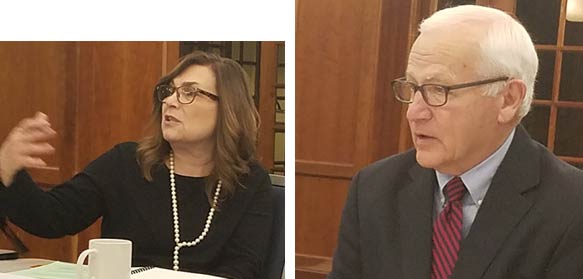
At its December 2018 meeting, the Center's Board of Directors approved eight research grant projects for the 2019 Research Grant Program. Pictured above: Board Secretary Dr. Nancy Falvo, and Board Chairman Sen. Gene Yaw. Pictured below left to right: Board Vice Chairman Rep. Garth Everett and Board Member Darrin Youker.
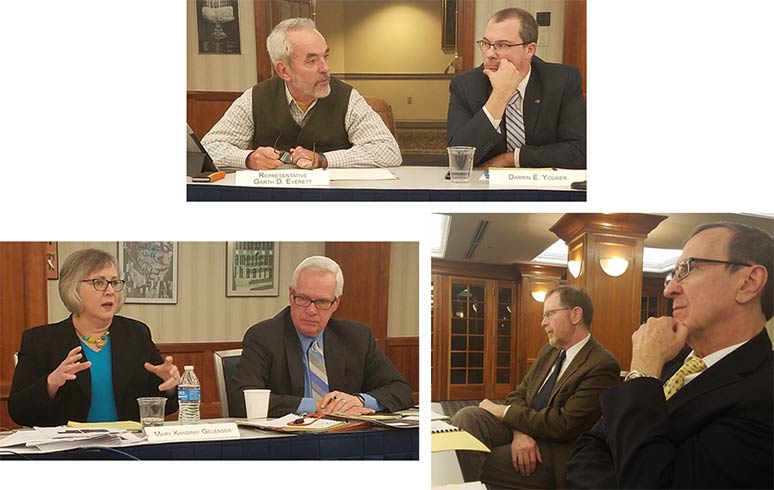
Pictured above left to right: Center Grants Manager Mary Kandray Gelenser, Center Director Barry Denk, and Board Members Dr. Timothy Kelsey and Dr. Stephan Goetz.
Chairman's Message
Happy New Year. I hope you had a good holiday season and are ready to begin this New Year with renewed inspiration. The New Year always brings a surge of activity at the Center as we prepare to kick off a new round of research grant projects. As noted on Page 1, the Center’s board approved eight new research projects as part of the 2019 Research Grant Program. It’s through this program that the Center identifies policy considerations for legislative and executive branch deliberation and action.
As we begin this new round of research projects €“ which are conducted by our faculty partners at Penn State University, the Pennsylvania State System of Higher Education universities, and the regional campuses of the University of Pittsburgh €“ Center staff is also busy reviewing draft final reports from the 2018 grant cycle. As these draft final reports filter into the Center’s office, staff reviews them for content, thoroughness, accuracy and contract compliance, and, afterward, prepares them for board review and acceptance.
All of this occurs while previously accepted reports are edited and prepared for publication and release to the General Assembly and the public. Page 6 features some findings of a recently released report on the economic benefits of the Pennsylvania state forest system. The research was completed by researchers at Penn State Harrisburg.
Over the next couple of months, the Center will also be identifying potential research topics for the Center’s 2020 grant cycle. At the first board meeting of every year, board members and staff bring potential research ideas to the table for review. The ideas are based on input from our board members’ working knowledge of rural Pennsylvania, and from members of the General Assembly, executive branch agency representatives, and other organizations that work closely with the Center. These ideas typically center around issues that rural communities are or may be addressing in the coming years, and they also come from prior research findings. Once the ideas for the next research round have been reviewed and approved as targeted research topics by the board, the Center will prepare and issue its formal 2020 Request for Proposals. That’s when another cycle begins and the work continues once again.
As always, we will continue to share the results of our research on rural Pennsylvania with you throughout the year. If you would like more details about the Center’s Research Grant Program, visit the Center’s Research Grant webpage.
Finally, on behalf of the board, I welcome Rep. Eddie Day Pashinski to the Center’s board. We look forward to his participation.
Senator Gene Yaw
Rural Snapshot: Survey of Small Town Municipal Officials
About the Survey
These are the results of a 2018 survey conducted by the Center for Rural Pennsylvania. The Center surveyed approximately 3,500 elected officials in boroughs and townships of the second class with populations under 2,500 in September 2018. The Center conducted the survey to get a more in-depth look at the more than 7,100 municipal officials who are governing Pennsylvania’s 1,503 smaller boroughs and townships. The Center compared the results of the survey with similar surveys conducted in 2008 and 1999. Names and addresses for the mail survey came from the Governor’s Center for Local Government Services.
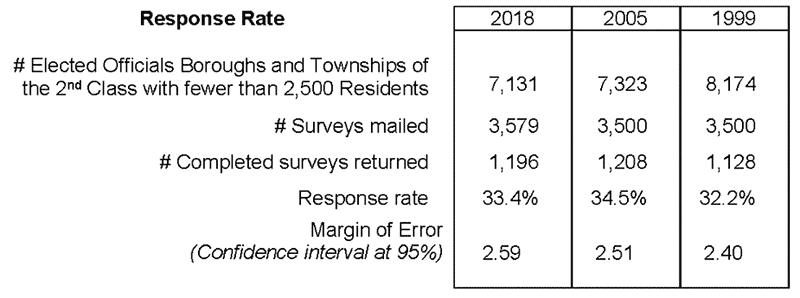
Average Age of Municipal Officials, 1999, 2005, and 2018
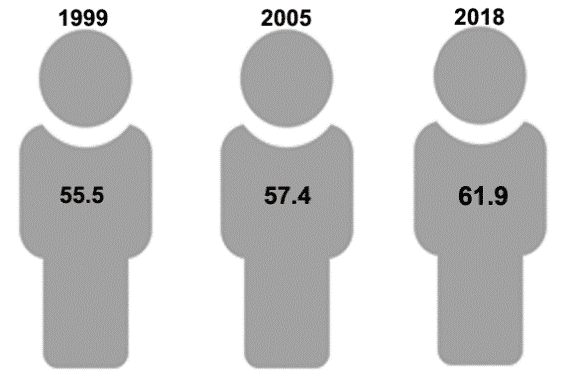
Females as Percent of Elected Municipal Officials, 1999, 2005, and 2018
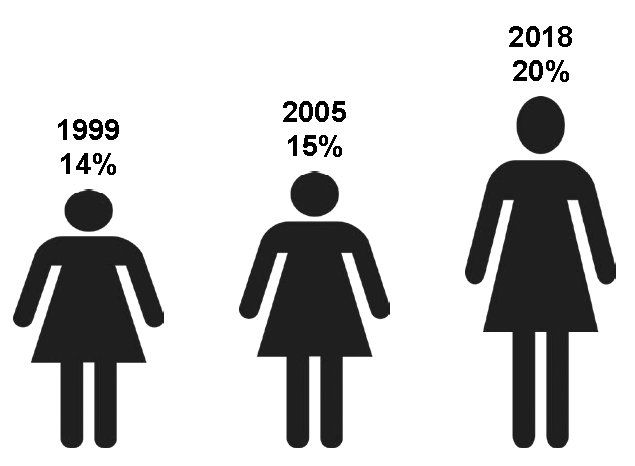
Average Number of Years as an Elected Municipal Official, 1999, 2005, and 2018
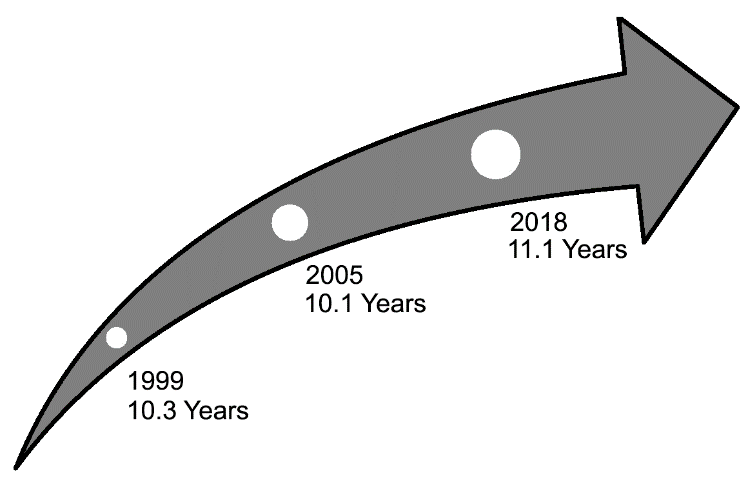
Top Three Reasons Why Municipal Officials Initially Sought Elected Office, 2018
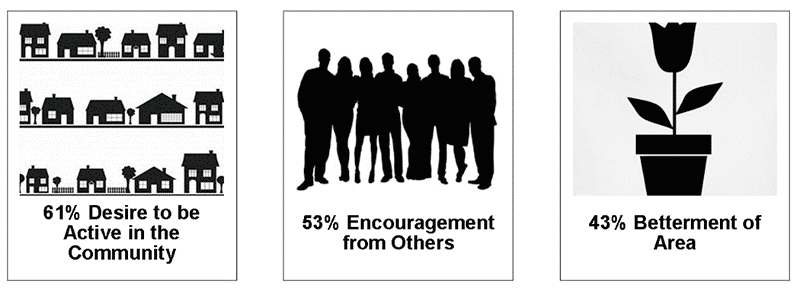
Average Number of Hours Spent on Municipal Business, Including Regularly Scheduled Meetings, 2018
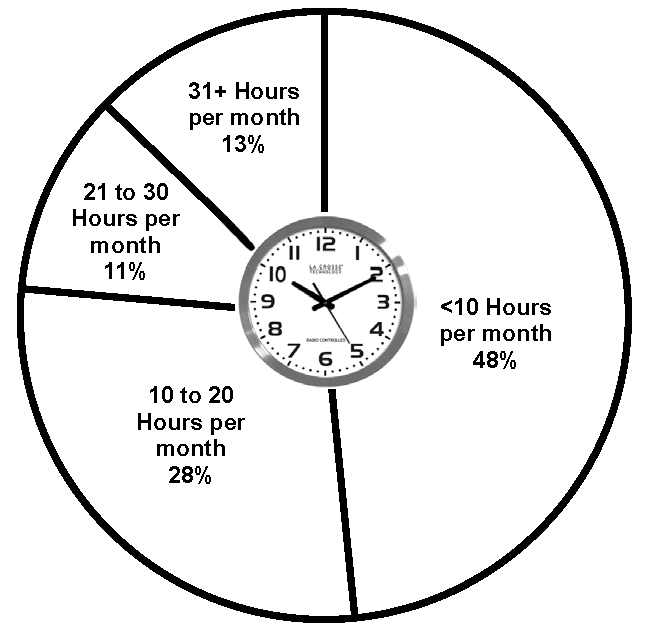
Three Most Important Issues for Municipal Officials, 2018
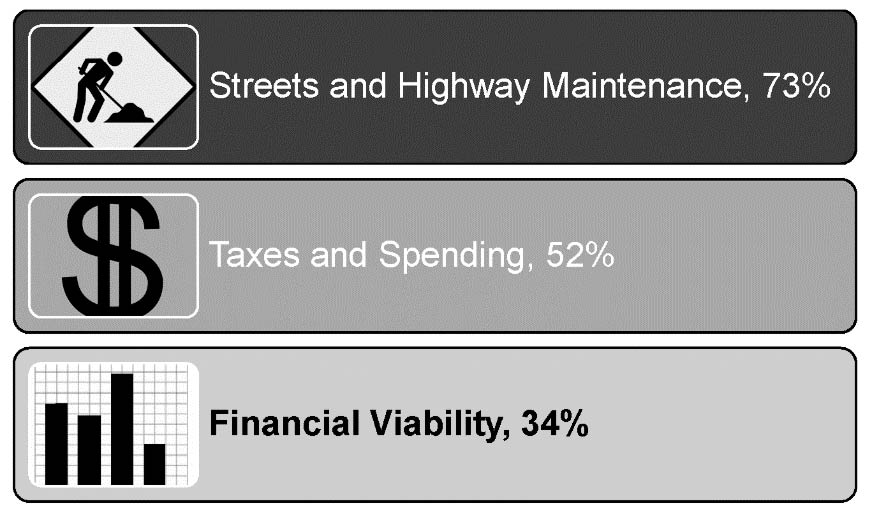
Percent of Municipal Officials Who, in their Most Recent Election, Ran Unopposed in Both the Primary and General Elections, 1999, 2005, and 2018


In 2018, 63 percent of elected municipal officials lived in the same municipality for 30 or more years.
Research Examines Economic Benefits of State Forest System
Pennsylvania is home to about 16.8 million acres of forestland, according to the U.S. Department of Agriculture’s Forest Service, and 2.2 million acres of that land are part of Pennsylvania’s state forest system. Over two-thirds of Pennsylvania’s counties, or 48 out of 67, have state forestland within their boundaries.
Recent research from faculty of Penn State Harrisburg now offers insights into the economic benefits of the Pennsylvania state forest system. The research, conducted by Dr. Bing Ran, Joseph Hafer, Francesca Angeles, Marie Ott, and Jessica Trimble, also provides insights into current state forest governance practices, including the payment-in-lieu of taxes (PILT) system. PILT provides monetary payments to local government jurisdictions €“ county, municipal, and school district €“ that have non-taxable state forestland within their jurisdictions.
To estimate income derived from the state forest system, the researchers compiled and analyzed 5 years of data (2012-2016) from the Pennsylvania Bureau of Forestry that detailed sales of state forest goods, such as timber, gas and oil. Over the 5-year period, the state forest sold about $632 million of forest goods, with oil- and gas-related sales accounting for about 80 percent of the total, and timber-related sales accounting for 18 percent of the total. On average, there were 544 bids and 141 timber sales each year.
The researchers also used existing data to conduct economic contribution and impact analyses for recreational trips made to state forestlands. For the contribution analysis, the researchers used existing data on how much people spend on recreational trips made to state forestlands. The data were from visitor-use-monitoring surveys conducted specifically for Pennsylvania’s state forests. According to the data, the total estimated annual expenditures associated with state forest visitation were nearly $400 million. The major industries associated with the expenditures were lodging, restaurants, groceries, and gasoline, which accounted for 87 percent of the total. The estimated total economic contribution to Pennsylvania’s economy related to these state forest recreational trips was 5,122 jobs, $180 million in labor income, $454.7 million in total output, and $266.7 million in value-added effects. The data also suggest that for every three jobs created by state forest visitation spending, one additional job will be created in Pennsylvania’s economy.
For the economic impact analysis, the researchers used existing expenditure data from survey-based estimates of how much out-of-state visitors spent on trip- and equipment-related items for hunting, fishing, and wildlife-watching in Pennsylvania in 2011. The total estimated annual expenditures associated with state forest visitation were approximately $93.4 million. The estimated total economic impact to Pennsylvania’s economy of spending related to these out-of-state state forest recreational trips was 1,716 jobs, $64 million in labor income, $117.4 million in total output, and $94 million in value-added effects. The data also suggest that for every three jobs created by out-of-state state forest visitation spending, one additional job will be created in Pennsylvania’s economy.
In terms of PILT, in 2016, payments were made to 386 local governments, 158 school districts, and 51 county governments statewide, for a total of $7.7 million, or about $2.57 million to each jurisdictional level. The PILT payment was set at $1.20 per acre per jurisdictional recipient ($3.60 total per acre), but has since increased to $2 per acre per jurisdictional recipient ($6 total per acre) per Act 85 of July 13, 2016. The research on state forest PILT systems in 10 peer states suggests that Pennsylvania’s flat-rate of $6 PILT per acre appears adequate compared to the PILT average-per-acre of peer states. Some states do not have a PILT system for state forestland. Those that do tend to have substantially more complicated PILT calculation systems than Pennsylvania’s, but come up with relatively similar payments.
For a copy of the research report, click here.
Just the Facts: Let's Eat Out
Hungry? If you’re in rural Pennsylvania, you may have to search a little harder to find a place to eat. In rural Pennsylvania, there are more than 5,100 restaurants, according to first quarter, 2018 data from the Pennsylvania Department of Labor and Industry. However, in urban Pennsylvania, there are 16,440 restaurants: that’s three times the number of restaurants in rural Pennsylvania.
Even after controlling for population, there are more restaurants in urban areas than in rural areas (175 per 100,000 urban residents vs. 150 per 100,000 rural residents).
From 2014 to 2018, the rural-urban restaurant gap widened as rural areas saw a 3 percent increase and urban areas saw a 6 percent increase in restaurants.
Spooning a little deeper into the soup pot, we also found some differences in the types of restaurants in rural and urban areas. For example, in 2018, there were 2,334 full-service restaurants in rural areas, and 6,716 full-service restaurants in urban areas. A full-service restaurant provides food to patrons who order and are served while seated and pay after eating. One piece of good news is that, per capita, the number of rural and urban full-service restaurants are similar. In rural areas, there are 69 establishments for every 100,000 residents, and, in urban areas, there are 71 establishments for every 100,000 residents. From 2014 to 2018, urban areas had a higher increase in these types of restaurants (8 percent) than rural areas (3 percent).
Want to grab a burger to go? Again, you may have to search a little harder in rural Pennsylvania. In 2018, there were 2,208 limited-service restaurants, or 65 for every 100,000 residents. Urban areas had 7,465 limited-service restaurants, or 79 for every 100,000 residents. In a limited-service restaurant, patrons generally order and pay for food before eating. From 2014 to 2018, rural and urban areas had similar increases in limited-service restaurants (6 percent).
In addition to full- and limited-service restaurants, there are also cafeterias, buffets, and snack bars. These are places where food is prepared and served using cafeteria-style or buffet service equipment and places that serve specialty snacks. In 2018, there were 569 of these types of restaurants in rural areas, or 17 for every 100,000 residents. In urban areas, there were 2,259 of these types of restaurants, or 24 for every 100,000 residents. From 2014 to 2018, these types of restaurants declined 3 percent in rural areas and increased 5 percent in urban areas.
The three counties with the most restaurants per capita were Lackawanna, Allegheny, and Clarion, each with more than 190 restaurants for every 100,000 residents. The three counties with the least restaurants per capita were Fulton, Perry, and Juniata, each with fewer than 105 restaurants for every 100,000 residents.
Nationwide, there were more than 553,100 restaurants in 2016, according to Census Bureau data. Per capita, that’s 171 restaurants for every 100,000 residents. The three states with the most restaurants were Rhode Island, New York, and Maine, each with more than 215 restaurants for every 100,000 residents. The states with the least were Kentucky, West Virginia, and Arizona, each with fewer than 147 restaurants for every 100,000 residents. Among all 50 states, Pennsylvania ranked 22nd, with 167 restaurants for every 100,000 residents.
